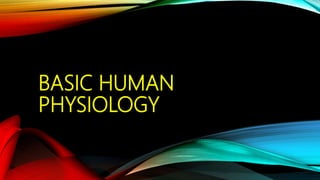
Basic human physiology
- 2. Physiology is the study of normal body functions working to maintain life and its constant internal environment. In contrast, Pathology is the study of how physiological processes of human body are altered in disease or injury.
- 3. HISTORY OF PHYSIOLOGISTS • Aristotle first speculated on body function • Erasistratus is considered the Father of Physiology. • Concept of blood flow given by Hazrat Imam Jafar Sadiq. • Description of the movement of blood through the pulmonary transit by the Syrian physician Ibn al-Nafis. • Diagram of the Eyes and Related Nerves Ibn al-Haytham • Walter cannon coined the term Homeostasis
- 4. HOMEOSTASIS It is the maintenance of constant internal environment of human body.(e.g. body temperature ,blood glucose level) Main components are • Stimulus(trigger e.g increased temp) • Receptor(skin temperature receptors) • Centre(nervous system) • Effector(skin arteries)
- 6. LEVELS OF ORGANIZATION 1. Organism 2. Organ systems(circulatory system, urinary system) 3. Individual organs(Liver, Stomach, Pancreas) 4. Tissues(epithelial tissue, connective tissue) 5. Cellular level(skin cells, red blood cells, neurons) 6. Chemical or molecular level
- 7. • Important to note: I. Cells make up tissues II. Tissues combine to form Organs III. Several organs make up a System e.g. Digestive system IV. Systems combine to form an Organism.
- 8. Organism
- 9. Cells
- 10. WHAT IS CELL MADE UP OF?
- 12. CHEMICAL CONSTITUENTS OF HUMAN BODY
- 14. ORGAN SYSTEMS
- 15. ORGAN SYSTEMS 1. Nervous system 2. Circulatory(cardiovascular) system 3. Digestive system 4. Urinary system 5. Respiratory system 6. Skeletal system 7. Muscular system
- 16. NERVOUS SYSTEM
- 18. CIRCULATORY SYSTEM • Our body contains about 5 litres of blood. • Three types of blood cells: Red blood cells, White blood cells and platelets. • Red cells transport oxygen from lungs to tissues. • White blood cells are part of body’s defense mechanism. • Platelets play vital role in the formation of clots at the site of injury.
- 19. BLOOD VESSELS
- 21. Digestive system
- 22. URINARY SYSTEM
- 23. • Kidneys: Nephron is the basic structural and excretory unit of a kidney. Each kidney contains 1-2.5 million nephrons.
- 25. MUSCULAR SYSTEM There are 640 muscles in our body
- 26. Skeletal, smooth and cardiac muscle cells
- 27. SKELETAL SYSTEM • There are 206 bones in adult human being. Bones articulate with other bones at joints through ligaments. • A muscle is attached to a bone by a Tendon. • There are normally 306 joints in human body
- 28. Knee joint showing ligaments between two bones(femur and tibia)
- 29. Muscle
- 30. INTERACTION OF RADIATION WITH CELLS • The basic difference between nuclear radiation and more commonly encountered radiation such as heat and light is that the former have sufficient energy to cause ionization. • Radiation can cause Ionization of water in cells. Formation of chemical species of this type are damaging to chromosomal material.
- 31. 1. Initial physical stage: energy is deposited in the cell and causes ionization. 2. Physiochemical stage: Ions interact with other water molecules resulting in a number of new products. 3. Chemical stage: Lasting a few seconds in which the reaction products interact with the important organic molecules of the cell. 4. The biological state: Death of a cell or prevention or delay of cell division or permanent modification which is passed onto daughter cells.